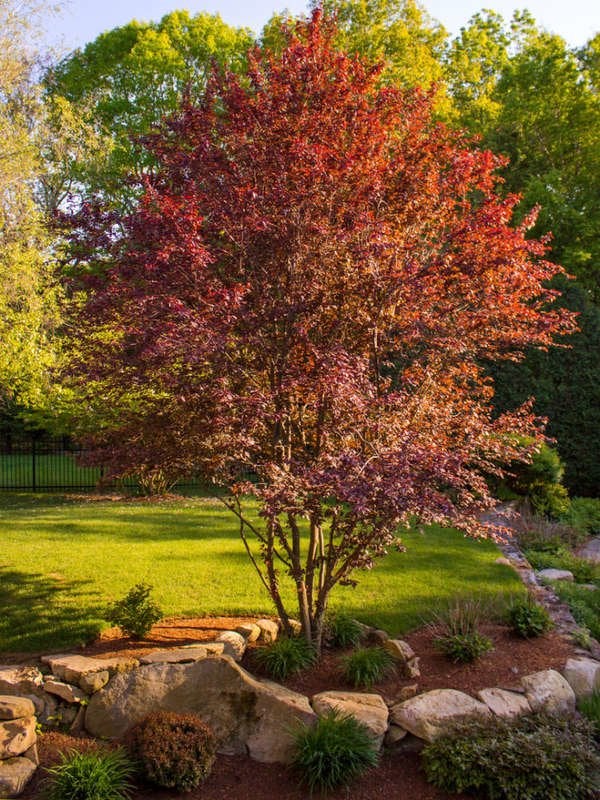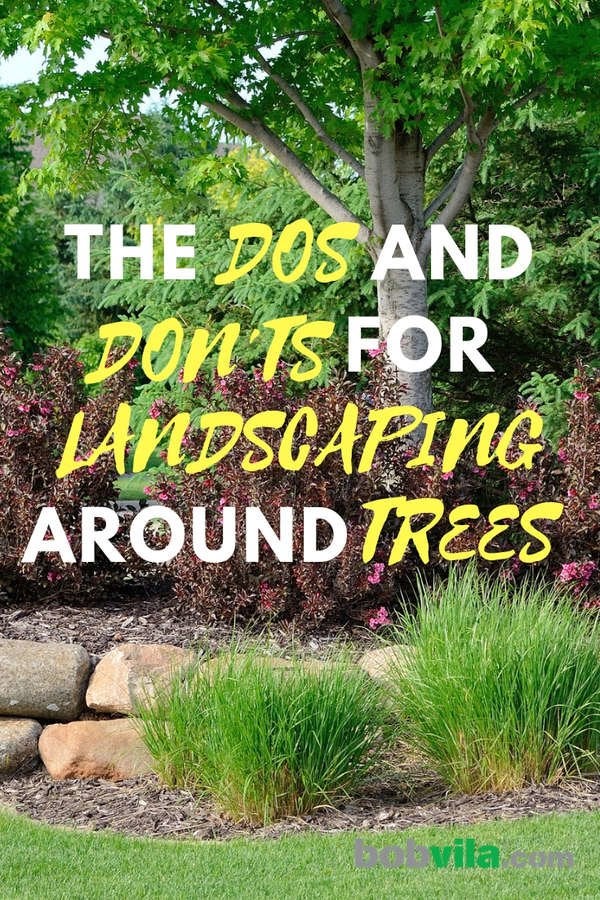How To Build Garden Bed Around Large Tree
The Challenges Around Trees
1/14

While mature trees bring shade and beauty to a residential landscape, the ground around their trunks can become a barren blight. Blame thirsty roots that draw up all the water and heavy branches that prevent sunlight from reaching the soil, making it tough for other plants to thrive. Fortunately, with the tips ahead, you can transform those desolate spots, adding color, texture, and other design elements—while maintaining the health of the tree—to make your yard the envy of the neighborhood.
RELATED: 10 of the Best Trees for Any Backyard
istockphoto.com
DO maintain the existing soil level at the trunk.
2/14

One common mistake that homeowners make is to create a raised border around a tree and then fill it in with soil to create a planting bed. The additional soil around the trunk can cause the bark to rot, leaving the tree susceptible to disease and insect infestation. If you want a raised bed, consider constructing an inside border one to two feet away from the trunk to keep the soil from smothering the base of the tree.
istockphoto.com
DON'T add soil over turf.
3/14

If making a garden bed, dig out any existing lawn grass before adding soil. You may assume that grass would simply decompose under the soil, but if it's thick it can create a layer of dense thatch that blocks water and oxygen from reaching the tree roots. By removing grass before building the bed with soil, the tree roots will receive the nutrients they need to keep the tree healthy and strong.
istockphoto.com
DO select plants adapted to the special light conditions under the tree.
4/14

Some trees, such as maples and magnolias, allow dappled sun through their boughs while others, including most evergreens, permit virtually no sunlight near their trunks. Before choosing plants, observe the amount of shade under the tree at different times of the day. Deep-shade plants such as ferns and hostas can thrive nearest the trunk, while semi-sun varieties like lily of the valley and coral bells can grow under the perimeter of the tree's branches.
RELATED: 15 Plants for Where the Sun Don't Shine
istockphoto.com
DON'T damage tree roots when planting.
5/14

Trees including white oak and hickory send down deep roots, but others, such as maple and cypress, have roots just beneath the surface, or, in some cases, even extending above the ground. Cutting into these roots with a shovel can severely damage a tree. Instead, use a hand trowel and carefully scoop out as much soil as you need to fit new plants into place. If you run into a root, stop digging and select a different spot for the plant.
istockphoto.com
DO mulch when establishing plantings beneath a tree.
6/14

Whether you're creating an entire raised bed or just tucking a few ferns here and there, the tree's roots will continue to absorb the lion's share of the water in the soil. Adding two to three inches of mulch around the base of new plants will help keep moisture in the soil so you won't have to water constantly. Use either commercial mulch, such as pine straw or wood chips, or recycled dried leaves.
istockphoto.com
DON'T pile mulch against the tree trunk.
7/14

The same rule that goes for soil goes for mulch–don't cover the base of the tree trunk. Leave eight to 10 inches of bare ground around the tree trunk when adding mulch.
istockphoto.com
DO consider bricks and rocks as a plant alternative.
8/14

Sure, plants are pretty around the base of a tree, but they require water and maintenance in the form of regular fertilizing and occasional trimming. If you'd haven't time to care for plants, consider an attractive arrangement of rocks; this is an especially good option for trees with roots that extend above the ground, which make planting difficult. Create an outside border of bricks, large stones, or commercial edging to keep small rocks from tumbling out on the lawn. Remember to leave eight to 10 inches between the rocks and the tree trunk.
istockphoto.com
DON'T use solid plastic sheeting under rocks.
9/14

Plastic landscape sheeting creates an impermeable barrier between the rocks and the soil. While this helps prevent weeds from growing between the rocks, it can damage trees, blocking oxygen and water from reaching the roots. A better option is to use porous landscape fabric beneath the rock layer and then pull stray weeds by hand should they appear.
RELATED: Don't Make These 8 Mistakes in Your Front Yard
istockphoto.com
DO incorporate a large tree into an outdoor living area.
10/14

If you wish to put a deck or a patio where a large tree already thrives, you needn't cut it down to proceed with your construction plans. Building around the tree will give you the best of both worlds: The deck or patio will provide attractive landscaping and you'll have instant shade for your entertaining area.
RELATED: 6 Fast-Growing Shade Trees
istockphoto.com
DON'T crowd the tree with a deck or patio.
11/14

The inside perimeter of a deck built around a tree should be a minimum of two feet from the tree's trunk to allow the trunk to grow, farther if you anticipate more growth. The inside border of a patio (because it's solid and will block water and air) should be three to seven feet (or more) away from the tree to give the roots plenty of surface area to absorb water. Plants or rocks can be used to landscape the space nearer the trunk (see above).
istockphoto.com
DO add relaxing elements to under-tree landscaping.
12/14

A mature tree with ample headspace beneath its branches is just begging for a charming stone bench, birdbath, or hammock. If you have the space, turn the area beneath a shade tree into a delightful spot for enjoying a cup of tea and a good book after a long day's work.
istockphoto.com
DON'T neglect the nighttime scene.
13/14

After all the hard work that went into landscaping around your trees, don't leave them in the dark when the sun goes down. Make the most of your new yard design by adding a few well-placed accent lights around the base. By installing solar or low-voltage landscape lights to softly illuminate plantings and rocks, you'll incorporate a whole new design element in the project.
istockphoto.com
Trim the Trees
14/14

Give your trees the star treatment.
bobvila.com
Don't Miss!

Whether you're a lawn care novice or a master gardener, everyone can use a little help around the yard. Subscribe to The Dirt newsletter for tips, recommendations, and problem-solving tools that can help you tame your great outdoors.
How To Build Garden Bed Around Large Tree
Source: https://www.bobvila.com/slideshow/the-dos-and-don-ts-for-landscaping-around-trees-52681
Posted by: duryeapecter.blogspot.com

0 Response to "How To Build Garden Bed Around Large Tree"
Post a Comment